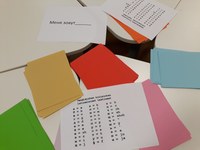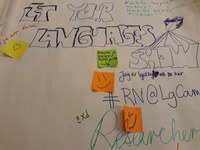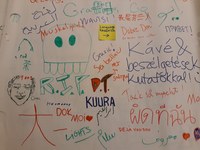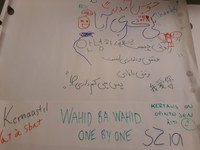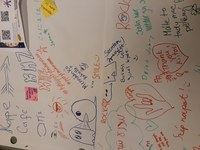One lovely spring day, the four of us–Tamás, Eeva-Leena, Kristiina, and Dmitri–came together to talk about an exciting opportunity to help bring research to people outside the Academia by arranging Language Campus activities at the European Researchers’ Night.
Needless to say, we wanted to make the event unique (or, rather, #JYUnique) for all of our participants capitalising on the linguistic and cultural diversity of the people in Jyväskylä, and the researchers at JYU and sharing the research that we do at Language Campus with society. After all we love asking questions about languages, so sharing our passion and sharing why finding answers to these questions is important for the society with this same society is the second best thing after finding these answers.
And, of course, we had to make sure that it was not boring, so it took us a while, in between the deadlines, teaching, data collection, and conferences, to decide on the programme and make sure it works. Anyway, this is what we had:
=) The morning programme was for school kids. Katja Mäntylä along with her students Amanda Aronen, Sofia Blomquist, and Emilia Peura are to thank for planning and organizing the programme called “Kielikoodin arvoitus” (Crack the language code). And the cracking was a great success! Eeva-Leena who was around in the morning, saw and heard how excited the children were.
Thank you, Katja, Amanda, Sofia, and Emilia; you nailed it!!
=) A Funny Language Quiz: we asked our wonderful colleagues to think about an interesting fact about or involving the language (i.e., any language or languages). The only requirement (besides them being connected to the language) was that it had to be a multiple-choice item with four options. The submissions were of great variety, so the Researchers’ Night visitors had the opportunity to try their knowledge of how many languages are spoken in Papua New Guinea, what ‘XP’ in Windows XP stands for, what ‘jalopeura’ (‘noble deer’) means, and how the word ‘spam’ came to mean ‘junk mail’ (if you have not seen this Monty Python’s sketch, go check it it out: https://youtu.be/anwy2MPT5RE). The multiple-choice format also helped us to talk about the issues with the format in language testing during the Language Campus Café (see below). Thank you all who submitted their items; these were great, and people had fun taking the quiz!
=) The graffiti wall with the goal of making our (meaning all of us, including the audience) languages visible. We were kind of sceptical about having it at first but decided to keep it in the end. And we did not regret it, as it appeared to be one of the highlights of events in Ruusupuisto building that evening. People were posting so many things in so many languages (though we had to remind them that Finnish was also one of them): a thank you in Italian, a poem in Arabic, a greeting in Polish, a Marxist quote in Finnish, postings in Swedish, Hungarian, Japanese, Estonian, and English, to name but a few. See for yourselves:
=) Last but far from least, Language Campus Café (coffee/tea to drink, cookies and apples to eat, and people to talk to). We thought that this was an opportunity for the researchers at the Language Campus to discuss their research with the main stakeholders of any research–the people. We had a number of discussions running: Rukhsana Tariq Ali talked about questioning and querying; Niina Sivunen discussed interaction between and with deaf asylum seekers; Outi Pippuri discussed the Sign Language Corpus, Ari Huhta and Dmitri Leontjev talked with the coffee drinkers about language assessment; Nettie Boivin explained how multiliteracies are involved in collaboration, creativity, and critical thinking (she also did a wonderful job in the afternoon, helping us with setting things up for the Café); Tamás Péter Szabó discussed creating multilingual learning spaces; and Kristiina Skinnari discussed CLIL as a way to teach and learn in two languages. The language café participants had their discussions in Finnish, English, Hungarian, Russian, a bit of Estonian, and Finnish Sign Language–a special thank you goes to the two Sign Language interpreters Veera Wusu and Virpi Sipilä for maintaining the flow of communication across Finnish Sign Language, Finnish, and English; you did a wonderful job, as usual. Our intention was not only to popularise our research but advertise the event as an opportunity for the visitors to practice their languages; that is, in addition to the drawing and writing on our graffiti wall, make their languages visible in discussing research over coffee. Judging by that some people returned for the second part of the café, they enjoyed it.
We thank all of those who contributed to making it happen and are looking forward to the next year’s Researchers’ Night!
Dmitri, Eeva-Leena, Kristiina, & Tamás
